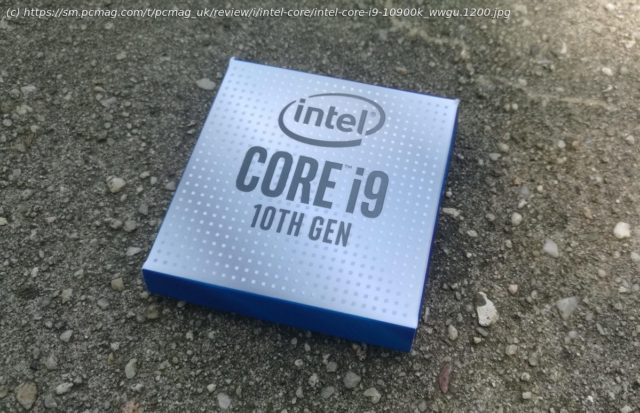Intel’s 10th Generation Core i9-10900K mainstream flagship CPU excels in elite gaming scenarios, but its aging architecture can’t quite keep pace with AMD’s newer, nimbler 7nm designs on value and multi-threaded performance.
The Core i9-10900K is the tip of Intel’s spear in its newest 10th Generation Core (“Comet Lake-S”) lineup of desktop CPUs. As a top-of-the-line 10-core processor (the estimated selling price is $488 for the bare chip), the Core i9-10900K posts great scores in gaming with our standard test GPU (even setting a record one title, Counter Strike: Global Offensive). But it doesn’t quite match up with AMD’s competing 12-core Ryzen 3900X in content-creation and highly multi-threaded tasks. The need for a new motherboard to upgrade to Comet Lake-S only adds to the real-world cost of the Core i9-10900K, and its thermal demands left us wanting.
If you already have a late-model gaming or content creation PC, it doesn’t do enough, at least at the moment, to justify the cost of adopting a whole new platform, especially in a world with strong Ryzen 9, Ryzen 7, and Ryzen 5 chips in AMD’s arsenal (plus the spanking-new Editors Choice Ryzen 3 3300X for gaming budget buyers). The peak Comet Lake-S CPU doesn’t change the overall desktop-CPU calculus much. If you’re in the market for a mega-core monster CPU for gaming and creative work on a mainstream platform, and don’t want to jump to the Intel Core X-Series or AMD’s Ryzen Threadrippers, the recommendation is the same today as it’s been since July of last year: Go with one of AMD’s mainstream AM4 chips instead.
Comet Lake-S: Reheating 14nm
The Core i9-10900K is, like all other Comet Lake-S chips in the full line, based on the same 14nm++ production process as 9th Generation desktop chips were. (See our overview of the family’s reveal earlier this month.) It comes at an interesting time for Intel, representing what could be (read: hopefully) the end of an era for its 14nm lithography.
SEE ALSO: TSMC Stops Taking Huawei Chip Orders
The whole Comet Lake-S stack makes use (now much refined, of course) of the same basic process technology as “Broadwell” back in 2014. With AMD’s Zen 2 CPUs, introduced from the second half of 2019 and into 2020, all integrating a 7nm chiplet-based architecture, it’s clear that Intel needed to pull out all the stops for 10th Generation if it hoped to remain relevant. After all, AMD is reportedly preparing for the launch of its Zen 3 architecture later this year.
The new Intel Core i9-10900K represents the top of an entirely new stack for Intel, reaching all the way down low-power-efficiency CPUs like the Core i3-10100T. The company has reintroduced its thread-doubling Hyper-Threading technology to many of the chip SKUs, a fan favorite that was broadly disabled in most 9th Generation desktop chips.
With the launch of Intel’s new 10th Generation stack of chips has come a new socket, LGA 1200, and a gigantic pile of new of motherboards to support it based on the new Z490 chipset. (Boards based on the cheaper B460 and H410 chipsets will follow in short order.)
Whether or not these 14nm++-based chips had be upgraded to all-new chipsets and series of platforms is Intel’s own calculation, but it’s clear that the company is doing all it can to squeeze as much juice out of 14nm before it’s retired sometime in, perhaps,2021. Given the chip maker’s much discussed issues with 10nm production, this new platform may be the final stretch of necessary 14nm highway before the bridge to a much smaller process technology.
The thing is, though, even with the new socket, new chipsets, and new platform, the whole works still feels behind AMD’s latest, in some respects. For one thing, Z490 doesn’t bring any massive new must-buy features. A second big reason: the lack of support for PCI Express 4.0. Despite the fact that AMD has supported PCIe 4.0 since the launch of the X570 chipset back in July of 2019, in near-June of 2020 Intel still has no “official” plans to support the new standard on Z490 motherboards. (We asked; it was a “no comment” situation.)
Now we say “official” in quotes because leaks correspond to some other indications from motherboard makers. According to a leaked internal slide acquired by VideoCardz.com (take as ever, leaks with a grain of salt; they can be faked), Intel’s upcoming plans for its next generation of desktop chips, dubbed “Rocket Lake-S,” include PCIe 4.0 support on the Z490 platform. Some makers of Z490 motherboards (including Asrock, Gigabyte, and MSI) have dubbed some of their Z490 motherboards PCI Express 4.0 “ready,” though what exactly they mean by that remains to be seen. As a result, it’s looking likely that Z490 isn’t just here for 10th Generation Core desktop, which makes sense when you consider Intel’s standard pace of socket upgrades over the years (that is, they last for two generations).
AMD, on the other hand, has been supporting AM4 for years now, and even just as we wrote this announced on Reddit its official plans to continue support for its coming Zen 3 CPUs on some of the later AM4 chipsets. The company is working wonders to ensure that the most possible customers have an affordable way to use their processors on existing hardware, from the bottom of the stack to the very top (excluding Ryzen Threadripper, of course, which is its own animal and saw a socket and chipset switcheroo with its latest generation).
Point being: If you’re planning to upgrade to the Intel 10th Generation chips as of today, at bare minimum you’ll need to factor in the cost of a new motherboard, which for Z490, at the lowest end, may cost you $199 and up for options like the budget-focused Asus TUF Gaming Z490-Plus. More-affordable boards that utilize the LGA 1200-compatible H410 and B460 chipsets are due to drop next week; however, users who go that route will have to sacrifice the option for overclocking, which precludes opting for the Core i9-10900K as a viable option. The “K” as ever means it’s unlocked for overclocking, and that is part of the appeal for some of the folks who buy at the top end of any Intel chip stack.
Intel vs. AMD Comparison: Core i9-10900K vs. Ryzen 9 3900X
Speaking of bucks, no Intel chip-stack launch would be complete without our value comparison to AMD. Let’s take a look at it versus its closest competition…
Hold that $499 price in thought for a moment on the Ryzen 9.
The Intel Core i9-10900K is a 10-core/20-thread CPU with an Intel UHD Graphics 630 integrated graphics processor (IGP) with a TDP of 125 watts, clocked to 3.7GHz at base. Intel claims the chip is capable of hitting 5.3GHz on both single-core and all-core tasks as long as the thermal limits of its “Thermal Velocity Boost” technology aren’t breached (more on that in a minute).
On the AMD side, the best point of comparison is the 12-core/24-thread Ryzen 9 3900X, at least on specs. On current street prices though, an interesting dynamic was playing out as we wrote this. AMD lowered the 3900X’s official list price to $449, and several retailers, among them Amazon and B&H, dropped this previously-$499 MSRP processor all the way down to $409, which we imagine was done in response (at least temporarily) to Intel’s pending launch and/or Memorial Day sales. At that price, if it sticks (there is no indication that it will), it’s difficult to even keep these two chips in the same category, a task that only gets more difficult once the benchmark numbers start rolling in. Even the “full” $449 list price is very competitive.
Now, back to that boost. According to the company line: “Intel Thermal Velocity Boost (Intel TVB) is a feature that opportunistically and automatically increases clock frequency above single-core and multi-core Intel Turbo Boost Technology frequencies based on how much the processor is operating below its maximum temperature and whether turbo power budget is available.






